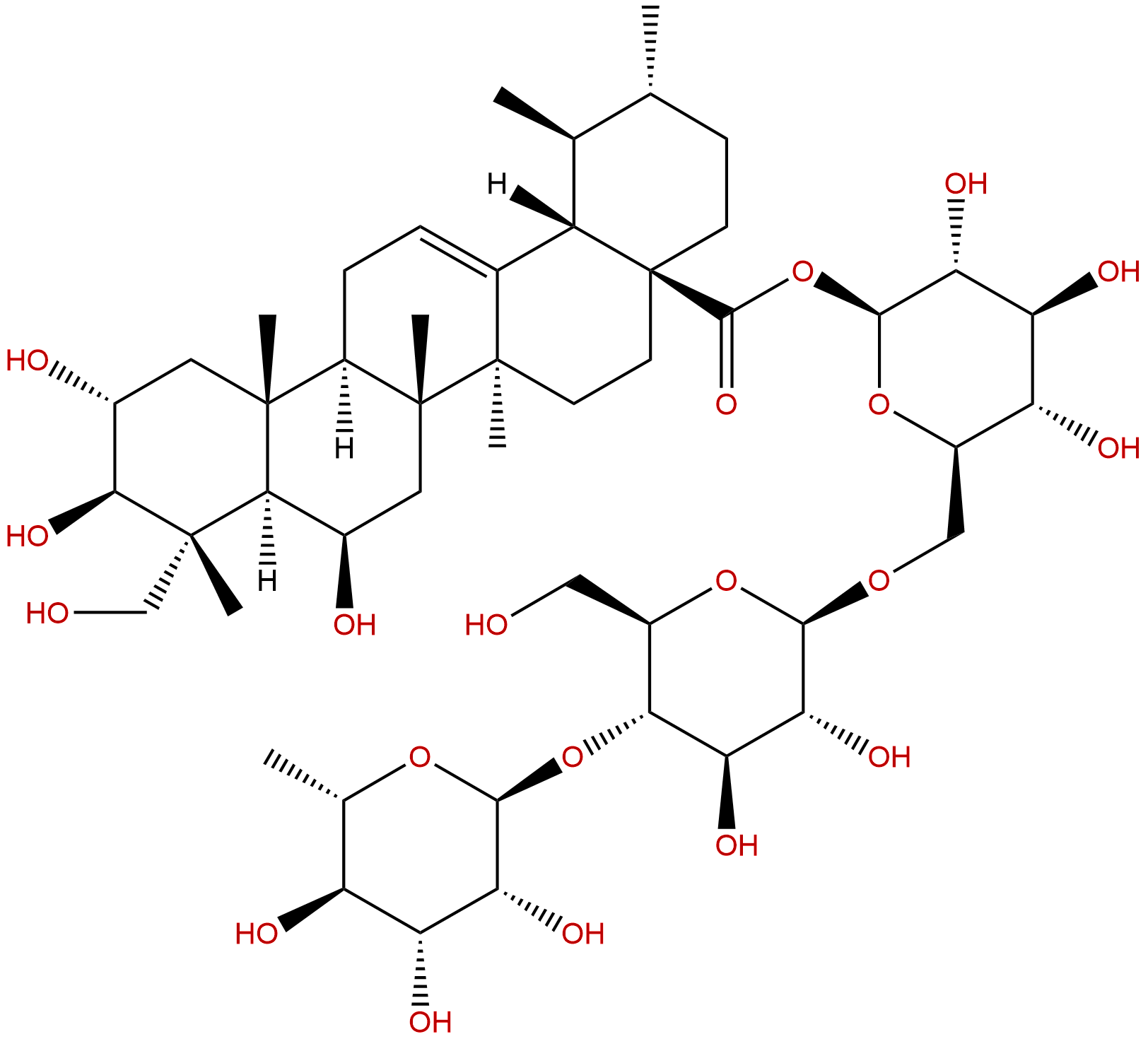
MadecassosideCAS No.:34540-22-2
|
||||||||||
 |
|
|
||||||||

| Catalogue No.: | BP0911 |
| Formula: | C48H78O20 |
| Mol Weight: | 975.132 |
Product name: Madecassoside
Synonym name: Asiaticoside A
Catalogue No.: BP0911
Cas No.: 34540-22-2
Formula: C48H78O20
Mol Weight: 975.132
Botanical Source: Centella asiatica (L.)Urb.
Physical Description:
Type of Compound: Triterpenoids
Purity: 95%~99%
Analysis Method: HPLC-DAD or/and HPLC-ELSD
Identification Method: Mass, NMR
Packing: Brown vial or HDPE plastic bottle
Storage: Store in a well closed container, protected from air and light. Put into refrigerate or freeze for long term storage.
Whenever possible, you should prepare and use solutions on the same day. However, if you need to make up stock solutions in advance, we recommend that you store the solution as aliquots in tightly sealed vials at -20℃. Generally, these will be useable for up to two weeks.
The product could be supplied from milligrams to grams
Inquire for bulk scale.
Description:
Madecassoside is a mechanism-based inhibitor of CYP2C19 and CYP3A4, which has antioxidant, anti-inflammatory, anti-apoptosis, wound-healing, and neuroprotective activities, It may have cardioprotective effects in LPS-mediated through inhibition of ERK, p38, and NF-κB activity, it inhibited the pro-inflammatory mediators, including COX-2 expression, PGE2 production, TNF-αand IL-6 levels and the up-regulation anti-inflammatory molecule IL-10.
References:
Phytomedicine. 2009 Jun;16(6-7):538-46.
Madecassoside attenuates inflammatory response on collagen-induced arthritis in DBA/1 mice.
Madecassoside (MA), a triterpenoid product isolated from Centella asiatica, has been described to exhibit antioxidant and anti-inflammatory activities.
METHODS AND RESULTS:
The present study was undertaken to determine whether Madecassoside (MA) is efficacious against collagen-induced arthritis (CIA) in mice and its possible mechanisms. DBA/1J mice were immunized with bovine type II collagen and treated with MA (3, 10 and 30 mg/kg d, i.g.) from days 21 to 42 after immunization. Arthritis was evaluated by hind paw swelling, polyarthritis index, and histological examination. In vitro proliferation of spleen cells was examined using 3-[4,5-dimethylthylthiazol-2-yl]-2, 5-diphenyltetrazoliumbromide (MTT) assay. Plasma levels of cytokines tumor necrosis factor alpha (TNF-alpha), interleukin-6 (IL-6), interleukin-10 (IL-10) and the expression of prostaglandin E(2) (PGE(2)), cyclooxygenase-1 (COX-1) and cyclooxygenase-2 (COX-2) in synovial tissues were also determined. The results showed that comparing with untreated CIA mice, treated with MA dose-dependently suppressed the clinical arthritis score and joints tissues pathological damage, reduced the proliferation of spleen cells, plasma levels of TNF-alpha and IL-6, synovial tissues PGE(2) production and COX-2 protein expression, however, the expression of COX-1 in synovial tissues did not change and the plasma levels of IL-10 were increased.
CONCLUSIONS:
These results suggest that MA can effectively alleviate inflammatory response on CIA, and anti-inflammatory effects of MA can be attributed, at least partially, to the inhibition of pro-inflammatory mediators, including COX-2 expression, PGE(2) production, TNF-alpha and IL-6 levels and the up-regulation anti-inflammatory molecule IL-10.
Brain Res. 2014 May 27;1565:37-47.
Neuroprotective effects of madecassoside against focal cerebral ischemia reperfusion injury in rats.
Madecassoside, a triterpenoid derivative isolated from Centella asiatica, exhibits anti-inflammatory and antioxidant activities.
METHODS AND RESULTS:
We investigated its neuroprotective effect against ischemia-reperfusion (I/R) injury in cerebral neurons in male Sprague-Dawley rats. Madecassoside (6, 12, or 24mg/kg, i.v.) was administered 1h after the start of reperfusion, and neurological deficit score and infarct volume were evaluated 24h later. Neuronal apoptosis was assessed by performing terminal deoxynucleotidyl transferase-mediated dUTP-nick end labeling (TUNEL) staining, and pathological brain damage was estimated by performing hematoxylin and eosin staining. Serum levels of malondialdehyde, superoxide dismutase activity, reduced glutathione levels, and nitric oxide levels were also determined. mRNA and protein expression of pro-inflammatory cytokines (Interleukin-1β/6, and tumor necrosis factor-α) were measured by real-time RT-PCR and ELISA, respectively; NF-κB p65 expression was determined by western blotting. Madecassoside significantly reduced brain infarct area, resolved neurological deficit, and ameliorated neuronal apoptosis. It also significantly reduced the levels of malondialdehyde and nitric oxide, and augmented the antioxidant activity in rats subjected to cerebral I/R. Moreover, the levels of pro-inflammatory cytokines and NF-κB p65 significantly reduced after Madecassoside treatment.
CONCLUSIONS:
These results indicate that Madecassoside is neuroprotective and may be useful in reducing the damage caused by stroke.
Planta Med. 2008 Jun;74(8):809-15.
Madecassoside isolated from Centella asiatica herbs facilitates burn wound healing in mice.
The current study was designed to investigate the effect of Madecassoside, the major triterpene in CENTELLA ASIATICA, on burn wound healing and its possible mechanism of action.
METHODS AND RESULTS:
An oral administration of Madecassoside (6, 12, 24 mg/kg) facilitated wound closure in a time-dependent manner and reached its peak effect, nearly completely wound closure, on day 20 in the group receiving the highest dose of 24 mg/kg of Madecassoside. Further histopathological analysis revealed that Madecassoside alleviated infiltration of inflammatory cells as well as enhanced epithelisation resulting from dermal proliferation of fibroblasts. Madecassoside at higher doses (12 and 24 mg/kg) decreased nitric oxide (NO) levels and malondialdehyde (MDA) content in the burn skin tissue. However, reduced glutathione (GSH) and hydroxyproline levels were increased in the same skin tissue. In addition, Madecassoside promoted skin angiogenesis IN VIVO, correlating with our findings IN VITRO that it stimulated endothelial cell growth in a rat aortic ring assay. These data suggest that Madecassoside has significant wound-healing activity and is one of the major reasons for the use of C. ASIATICA herbs in the successful treatment of burn injury.
CONCLUSIONS:
Moreover, the results from the present study indicate that the effect of Madecassoside on wound healing may involve several mechanisms including antioxidative activity, collagen synthesis and angiogenesis.
HPLC of Madecassoside

HNMR of Madecassoside
